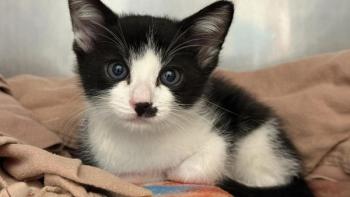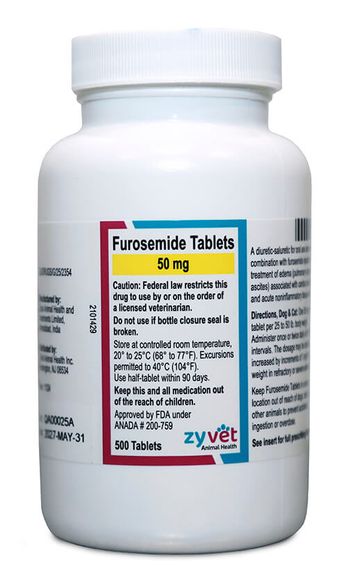
Inappropriate elimination in cats: doctor, staff, and patient survival (Proceedings)
The most common behavior problem of cats is inappropriate elimination (IE). It is the cause of owners taking drastic measures including banning the cat to the outdoors, abandonment, surrender to a shelter, and euthanasia. It is important that a simple cookbook answer not be used for these cats as is illustrated by the approach that I use.
The most common behavior problem of cats is inappropriate elimination (IE). It is the cause of owners taking drastic measures including banning the cat to the outdoors, abandonment, surrender to a shelter, and euthanasia. It is important that a simple cookbook answer not be used for these cats as is illustrated by the approach that I use.
Most IE is driven by a behavior disorder. However, there is almost always something that initiates the problem. Sometimes IE begins with a stress-producing or insecurity-producing event. Sometimes it begins due to a medical condition. We need to try to find the initiating event and deal with it. If we can do so, treatment for the initiating event is done simultaneously with treatment for the behavioral aspect. However, sometimes the initiating event is resolved, and we only left with the behavioral aspect. But, failing to look for the initiating event can be a disastrous oversight when dealing with this problem.
Underlying medical causes
Although many cats present with behavior-driven IE, this behavior may originate in several physical abnormalities. It is important to address these before proceeding to behavior modification techniques. History is sufficient for some; specific tests are needed for others.
Cystitis
Bladder inflammation, whether sterile or bacterial, frequently results in inappropriate urination. These cats typically have one or more clinical signs of dysuria, pollakiuria, increased frequency of urination, and hematuria. However, these may be present and missed by owners. Urinalysis usually reveals bacturia, hematuria, and crystalluria although some affected cats will have a normal urinalysis. A urine culture is the most sensitive way of detecting bacturia. Bladder ultrasound can detect chronic cystitis (thickened, irregular bladder walls) as well as uroliths.
Pain
Certain types of pain may be manifested when the cat goes to the litter box and positions to urinate or defecate. Most notable is pain from the lumbar spine, lumbosacral junction, hips, and knees. Uroliths in the bladder can also create pain that is manifested when the cat urinates. The discomfort associated with constipation can also be litter box related. These cats' histories may include lameness, reluctance to jump or run, failure to raise the tail when petted, increased sedentary lifestyle, hiding, personality change (especially aggression), reluctance to being picked up, sitting or lying down slowly, a hunched up posture of the back, standing (instead of squatting) in the litter box when urinating or defecating) and protecting a body part. Radiographs of these areas are diagnostic. Litter box-related pain can also be generated by ingrown toenails, especially in older cats, and clumping litter that sticks to the hair on the ventral surface of the feet. These can be detected by examination of the feet. Impacted or infected anal sacs will become painful when the cat defecates, sometimes resulting in a litter-box-pain association. Anal sac palpation or expression is diagnostic.
Polyuria
Polyuria may cause a cat to urinate inappropriately. Common causes of polyuria in cats include diabetes mellitus, renal disease, and hyperthyroidism. Blood panels that include glucose, creatinine, BUN, and total T4 are diagnostic.
Very Ill Cat
Very ill cats often do not have the energy to walk across the room or the house to get to the litter box. They will often urinate (or defecate) where they lie.
The work up
The ideal workup consists of directed history taking, physical examination, a blood chemistry panel including total T4, radiographs of the abdomen, lumbar spine, hips, and knees, bladder ultrasound, urinalysis, urine culture, and anal sac palpation/palpation. When possible, the minimal workup should consist of directed history taking, physical examination, anal sac palpation/expression, radiographs, and urinalysis. Your clinical judgment and the owner's motivation and finances will direct how extensive your workup can be.
Litter box issues
Cats will avoid litter boxes under several situations that include:
- Too few litter boxes for the number of cats in the household. The "official" recommendation is one more litter box than the number of cats. This is not practical for many cat owners, but it is a rule that should be imposed, or at least discussed.
- Hooded litter boxes. Although there are many advantages to hooded litter boxes (for owners, at least) odors are trapped within the litter box making it undesirable to many cats. Hoods should be removed, at least until the problem is resolved.
- Type of litter. Clumping litter best simulates sand or soil and is preferred by most cats. It is my litter-type of choice unless it is heavily scented or deodorized. When IE is occurring, avoid clumping litters for "multiple cats" due to the odors that may offend cats. If the owner objects to dusty clumping litter, recommend that a higher quality product be purchased. Synthetic litters made from wheat, newspaper, etc. can result in substrate aversion. Although well accepted by many cats, I recommend avoiding them in IE situations.
- Recent change of litter type or brand. Cats are creatures of habit. A change in the litter type or a different brand of the same type can result in IE.
- Dirty litter box. The litter box should be scooped each day (several times if used by multiple cats) and dumped and scrubbed once per month.
- Location. Cats often avoid litter boxes that are in high traffic areas and prefer those in somewhat secluded locations.
- Litter box liner. Some cats do not like these liners. When IE is occurring, remove them.
- Side height. Cats with arthritis can have difficulty climbing in or out of litter boxes with sides that are 4 inches or more high.
Household issues
The smell of urine will attract the cat so it is imperative that it be removed from carpet, other flooring, furniture, and bedding. If the item is washable, do so with hot water and bleach if possible. It is important to find all of the areas in carpet; this can be accomplished with the use of a black light. Most owners find more areas than they were aware of. Treating the pad is paramount. To do so, pour ½ cup of water on the area and spray the carpet with Zero Odor Pet®. This is the most effective odor removal product that I have used. Zero Odor Pet can also be used in and around the litter box to remove lingering odors.
The pheromone Feliway® can be used to mark the cat's "good zones." As a rule, cats will not urinate or defecate in their "good zones." It should be sprayed on the locations of IE; alternatively, the Feliway Diffuser can be used when many areas need to be treated in the same room.
If these approaches are not successful in keeping the cat from continuing to urinate in certain spots, cover the spots with aluminum foil. It should be taped to the floor with masking tape so the cat does not move it.
The behavior aspects
Inappropriate elimination may be a primary behavior disorder or a secondary behavior disorder initiated by the diseases previously discussed. Obviously, if another primary disease is present, it must be addressed. However, specific measures must be taken to address the behavioral component. Situations that cause stress and insecurity need to be explored. Common causes include:
- - A new pet (especially a puppy or kitten) or person in the household.
- - A pet or person who left the household.
- - New carpet, drapes, furniture.
- - Rearrangement of furniture.
- - Cat moved to new home.
- - Harassment of the cat by other cats, dogs, or children.
- - Too many cats in the household. For each additional cat there is a 10% increase in likelihood that IE will occur. If the owner has 8 cats, there is an 80% chance of IE problems.
Solutions
There are many aspects to dealing with this problem. Piecemealing the treatment protocol is much less effective than using all of your tools at once.
1. Diagnose and treat underlying diseases.
2. Identify stress or insecurity producing situations. Elimination of any of these situations (when possible) is very beneficial to successful treatment.
3. Correct litter box issues. Addition of Cat Attract Litter Additive® to the litter can make the odor in the litter box attractive instead of offensive to the cat.
4. Find all areas of IE with a black light. Remove the odor in these areas with Zero Odor Pet.
5. Create "good zones" with Feliway to discourage the cat from returning to previously soiled areas.
6. Put the cat on a psychoactive drug. My first choice is buspirone (BuSpar®). If it is used with all of the above for 2 weeks without response, I change to clomipramine (Clomicalm®). If that is not successful, I use fluoxetine (Prozac®).
Prognosis
There are three factors that influence prognosis. 1) Identifying and elimination of stress or insecurity-producing situations improves the prognosis significantly. 2) Duration is also extremely important. If I begin working with a cat with IE with less than 1 month duration, I give a good prognosis. If IE has been present more than 6 months, the prognosis is poor. If it has been occurring more than one year, I do not recommend treatment. 3) Client compliance/motivation is critical. Some clients just want a quick fix with little expense or effort on their part. This attitude will almost always result in failure.
References
Black light: Streamlight Twin Task 3C,
Zero Odor Pet, Zero Odor, LLC, Pound Ridge, NY; 914-764-1566 or
Feliway, Ceva Animal Health, Lenexa, KS.
Cat Attract Litter Additive, Precious Cat, Inc., Englewood, CO.;
BuSpar, Bristol-Meyers Squibb Co., Princeton, NJ.
Clomicalm, Novartis Animal Health, Inc., Greensboro, NC.
Prozac, Eli Lilly and Company, Indianapolis, IN.
The following is attached to any dispensed Metacam transaction and appears at the bottom of the client's receipt:
- Do not give Metacam with NSAID's (aspirin) or steroids (prednisone or prednisolone).
- Meloxicam (Metacam®) is being dispensed for use in your cat to control pain. It is often used for post-surgical pain or for chronic arthritis. This drug is approved for one-time and chronic use in dogs in the U.S, but it is only approved for use in cats as a single injection.
- Meloxicam is approved (by the equivalent of the FDA) in many countries in Europe, in Australia, and in Canada for one-time and chronic use in cats, and several recent papers have been published demonstrating its safety for both uses. However, the FDA requires the manufacturer to add this statement to the Metacam box: "Warning: Repeated use of meloxicam in cats has been associated with acute renal failure and death. Do not administer additional doses of injectable or oral meloxicam to cats."
- Acute kidney failure is a rare complication, but it is a very serious one. The kidney damage that occurs is irreversible. The main cats so affected are those with previously compromised kidney function or those that are dehydrated.
- This creates a dilemma for us in regards to your cat's pain control. There is only one good alternative, and it is very expensive (over $100 per week for treatment). If it were not for the expense, we would use this drug exclusively, but we know the economic realities of treating cats.
- Although we are recommending the use of Metacam in your cat, we want you to be informed and to feel that you have the option for declining its use. If you feel that way, please do not hesitate to discuss this with us. We are happy to look at alternatives.
Inappropriate Elimination History Form
Newsletter
From exam room tips to practice management insights, get trusted veterinary news delivered straight to your inbox—subscribe to dvm360.






